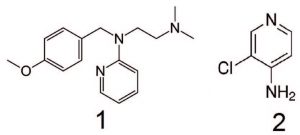Unique Selectivity on a Cogent Amide Stationary Phase
The Cogent Amide column offers unique selectivity that may not be readily attainable with other phases. Two test solutes shown in this application note (Pyrilamine and 4-Amino-3-Chloropyridine) were baseline separated on the Cogent Amide column (Figure A), but they co-eluted with no resolution on a different Cogent column using otherwise equivalent method conditions (Cogent Diamond Hydride™, Figure B). The presence of the Amide ligand provides additional selectivity that can make a significant difference in resolving closely- eluting compounds such as these.


Peaks:
1. Pyrilamine
2. 4-Amino-3-Chloropyridine
Method Conditions
Column: Cogent Amide™, 4μm, 100Å
Catalog No.: 40036-05P
Dimensions: 4.6 x 50mm
Mobile Phase:
—A: 90% DI Water / 10% Acetonitrile / 0.1% Formic Acid (v/v)
—B: B: Acetonitrile / 0.1% Formic Acid (v/v)
Gradient:
| Time (Minutes) | %B |
| 0 | 90 |
| 1 | 90 |
| 7 | 50 |
| 8 | 90 |
Post Time: 3 minutes
Flow rate: 1.0 mL/minute
Detection: UV 244 nm
Injection vol.: 2μL
Sample Preparation:
100 mg/L Pyrilamine and 4-Amino-3-Chloropyridine reference standards in diluent of 50/50 solvent A/solvent B. Peak identities confirmed with individual standards.
Note: Amine-containing compounds such as Pyrilamine and 4-Amino-3-Chloropyridine can be difficult to analyze using conventional silica- based stationary phases. These columns have residual silanol groups on the surface that can interact electrostatically with Amines, causing peak tailing. Chromatographers use a number of strategies to avoid these issues, such as use of ion pair agents or endcapping. However, Cogent TYPE-C Silica phases are virtually free of silanols, and therefore good peak shapes can be obtained without these workaround method strategies.
Attachment
No 352 Pyrilamine and 4-Amino-3-Chloropyridine.pdf 0.4 Mb Download File


